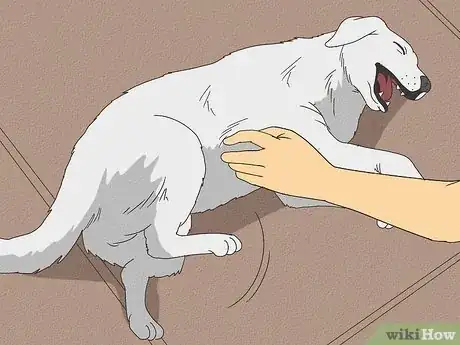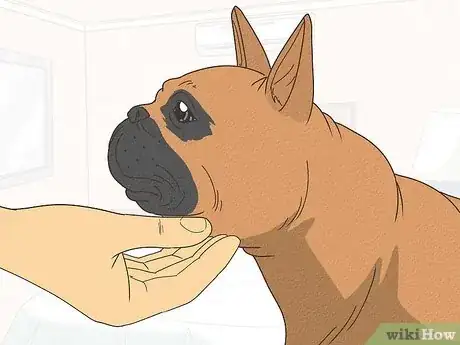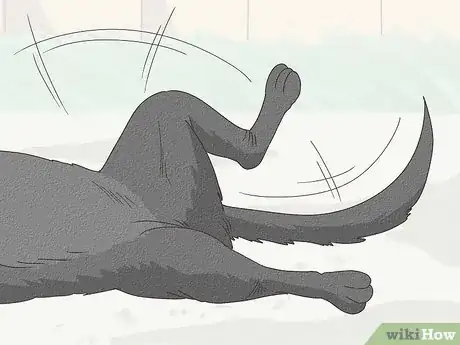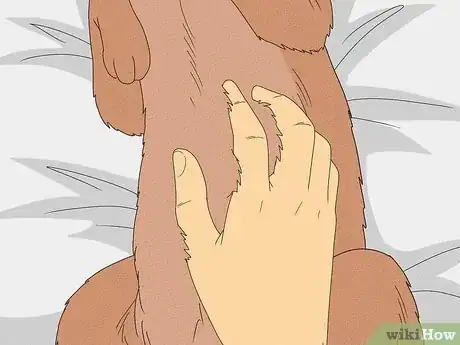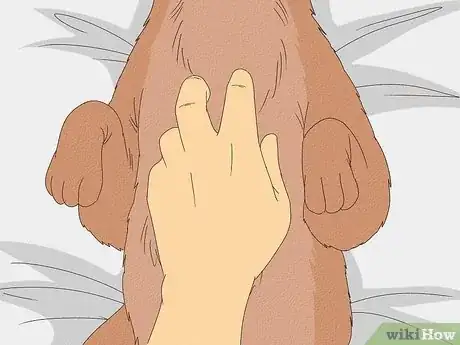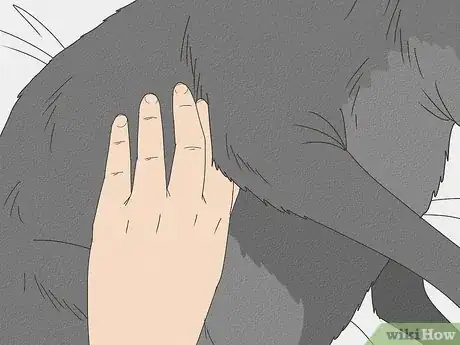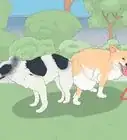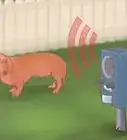This article was co-authored by John Jess and by wikiHow staff writer, Eric McClure. John Jess is a Dog Breeder and the Founder of Central Illinois Doodles, a family business located in Arthur, Illinois. He specializes in breeding Goldendoodles and Bernedoodles. Central Illinois Doodles has been named one of the Top 10 Bernedoodle breeders in the United States by Bubbly Pet and Pupvine. They’ve also been named one of the best Goldendoodle breeders by Trending Breeds and Devoted to Dog.
There are 9 references cited in this article, which can be found at the bottom of the page.
This article has been viewed 5,804 times.
Wondering if dogs are ticklish? Trying to get a laugh out of your pup? Believe it or not, people and dogs have a lot in common—including the ability to be tickled. However, while you may enjoy the occasional tickle fight, your dog may not find this sensation enjoyable. That’s why it’s so important to pay attention to your dog’s reaction when you tickle or pet them. If they shy away, leave them alone; if they wag their tail and beg for more, keep on tickling! In this article we’ll explain how dogs experience tickling, where dogs are ticklish, and how you can know if they’re having fun or not.
Things You Should Know
- Dogs are ticklish, but not in the “belly tickle laughing” kind of way. Some dogs enjoy being tickled, but many do not.
- Pay attention to your dog’s body language when you tickle them to see if they enjoy it or not. A dog will let you know if they’re having fun.
- The best spots to tickle a dog are behind the ears, under the chin, and between their front legs. These are almost always good spots, but know that they might not work for every dog.
Steps
Are dogs ticklish?
-
Yes, dogs can be tickled. There are two types of ticklishness—knismesis, which is an involuntary reaction to a skin sensation (picture how you feel when a bug is on you) and gargalesis, which is an involuntary laughter to something touching your sensitive areas (imagine someone tickling your belly). Dogs definitely experience knismesis, and many enjoy the sensation![1] X Research source
- It’s unclear whether dogs can experience gargalesis, although many dog owners seem to believe they do. It just hasn’t been studied and observed the same way as knismesis has.
- Knismesis is the source of a dog’s “scratch reflex.” This is the natural scratching and shaking a dog will do when they feel something foreign on their skin.
- To clarify, dogs will not find this kind of tickling funny, although they may find it very satisfying, kind of like that feeling you get when you scratch an itch.
Do dogs like to be tickled?
-
1Most dogs find tickling to be enjoyable. Dogs are unique individuals and while some dogs won’t be the biggest fans of tickling, many pups will love it.[2] X Research source You can tell a dog likes being tickled if they:
-
2Some dogs do not enjoy the sensation of being tickled. A lot of dogs just aren’t going to react positively to the feeling of their skin being tickled, so this isn’t for every dog. If your dog hops back or shows any signs of discomfort, stop tickling them and let them be.[3] X Research source A dog that doesn’t like being tickled may:
- Shy away from you or avoid your hand.
- Yip or growl in response to your tickle.
- Tuck their tail, pull their ears back, and show their teeth.
- Try to make themselves smaller by balling up.
How do I tickle my dog?
-
Lightly rub your dog with your fingernails or finger pads to tickle them. Instead of a deep, intense pat, try barely rubbing the surface of your dogs skin. Move your fingers back and forth to stimulate them. If they don’t like your nails, try using the pads of your fingers. Some dogs like it firmer while other dogs prefer a lighter touch. Give it 3-5 seconds and see how they react.[4] X Research source
How do I know my found my dog’s tickle spot?
-
Your dog’s will thump their foot or wag their tail if you got the right spot. If you’re tickling your dog behind the ears and they’re just looking at you confused and emotionless, you probably need to keep exploring. Your dog will be visibly excited and animated if you’ve found the right spot. They’ll come back for more if they’re into it.[5] X Research source
- Take your dog’s previous behavior into account. If they normally love belly rubs, they’ll probably enjoy having their belly tickled.
The Best Ticklish Spots
-
1Behind the ears This part of your pup is covered in nerve endings, so it’s a sensitive part of your dog’s body. It also happens to be a favorite scratching spot. If you need a solid spot to test your tickling, try the area behind their ears.[6] X Research source
- There’s a reason dogs love scratching behind their own ears!
-
2Belly This is one of those coin-flip spots for dogs. Your pup either really loves belly rubs or hates them. Give it a shot and tickle them slowly on their belly to see if they like it.[7] X Research source
-
3Between their front legs This is a favorite spot for a lot of dogs, probably because it’s a good middle ground between their sensitive tummy and their face (where dogs don’t typically like being touched).[8] X Research source
- This also tends to be a great bonding spot for you and your dog if you’ve just adopted them!
-
4The armpits This is a part of the dog’s body that they can’t easily scratch on their own. As a result, some dogs really enjoy being tickled on their torso behind their front arms. However, some dogs find this area a no-go zone, so don’t force it if your pup backs away when you touch them near their armpits.[9] X Research source
-
5Under the chin If a dog trusts you, they’ll typically love a scratch under the jaw. Dogs use their mouth for all kinds of things, and their jaw muscles can get pretty sore. Tickling a dog under their chin can be extremely comforting and enjoyable for them.[10] X Research source
-
6Base of the tail Some dogs really hate this one, but if your dog enjoys the occasional butt scratch, they may enjoy being tickled at the base of their tail (on top, not underneath). Give them a light tickle at the base of the tail and see how they react.[11] X Research source
Are dogs ticklish on their paws?
-
Unlike humans, dogs don’t typically like people tickling their feet. Dogs tend to really dislike having their paws handled. The skin between your pup’s paw pads is extremely sensitive, and dogs rely entirely on their paws for mobility. As a result, dogs have evolved to be very guarded and protective of their feet, so don’t try tickling your dog’s paws.[12] X Research source
- This is also why your dog may give you such a hard time when you try to trim their nails.
Why do dogs roll over when you tickle them?
-
1If they roll over when you’re petting them, they want a belly rub! If you’re playing with your pup or you’re giving them pets and they roll over, they’re kindly requesting your assistance with a belly rub. Give them what they’re asking for![13] X Research source
- If you’re playing a little rough with your dog or wrestling and they roll over, it’s probably a combat tactic. They need a break, so give them a second to catch their breath before you keep playing.[14] X Research source
-
2If they roll over when you approach them, they’re being submissive. If your pup flops over onto their back when you walk towards them, they probably don’t want a belly rub—they’re just showing you they don’t want to fight. This is a natural maneuver dogs pull in front of people and animals they view as leaders. Get down slowly, greet your dog kindly, and slowly rub their belly to let them know you’re being friendly.[15] X Research source
- Some dogs will roll over when they’re scared. If your dog tucks their tail when they do this or they whimper, sit with them and give them treats to let them know you aren’t a threat. You two will build a bond, it just takes time!
You Might Also Like
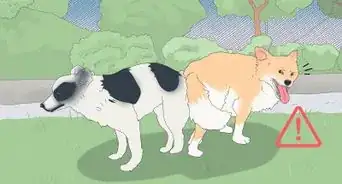 How Long Does it Take for Dogs to Get Unstuck After Mating?
How Long Does it Take for Dogs to Get Unstuck After Mating?

 10 Comforting Things to Say (or Text) to a Friend When Their Dog Dies
10 Comforting Things to Say (or Text) to a Friend When Their Dog Dies
 How to Sell Puppies
How to Sell Puppies
 12 Common Reasons Why Dogs Put Their Ears Back
12 Common Reasons Why Dogs Put Their Ears Back
 How to Get Dogs to Stop Eating Rabbit Poop
How to Get Dogs to Stop Eating Rabbit Poop

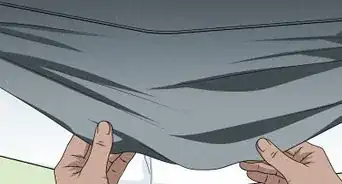 How to Clean Dog Pee from a Mattress
How to Clean Dog Pee from a Mattress




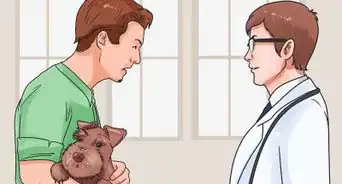
References
- ↑ http://charris.ucsd.edu/articles/Harris_EHB2012.pdf
- ↑ https://news.yahoo.com/dogs-ticklish-know-scratching-good-193125582.html
- ↑ https://www.dailypaws.com/dogs-puppies/dog-behavior/dog-psychology/are-dogs-ticklish
- ↑ https://www.dailypaws.com/dogs-puppies/dog-behavior/dog-psychology/are-dogs-ticklish
- ↑ https://www.dailypaws.com/dogs-puppies/dog-behavior/dog-psychology/are-dogs-ticklish
- ↑ https://www.dailypaws.com/dogs-puppies/dog-behavior/dog-psychology/where-do-dogs-like-to-be-pet
- ↑ https://www.dailypaws.com/dogs-puppies/dog-behavior/dog-psychology/are-dogs-ticklish
- ↑ https://www.pettsie.com/blogs/blog/7-best-spots-where-dogs-love-to-be-scratched
- ↑ https://www.dailypaws.com/dogs-puppies/dog-behavior/dog-psychology/where-do-dogs-like-to-be-pet
- ↑ https://www.dailypaws.com/dogs-puppies/dog-behavior/dog-psychology/where-do-dogs-like-to-be-pet
- ↑ https://www.dailypaws.com/dogs-puppies/dog-behavior/dog-psychology/where-do-dogs-like-to-be-pet
- ↑ https://www.pawschicago.org/news-resources/all-about-dogs/doggy-basics/canine-senses
- ↑ http://www.vetstreet.com/our-pet-experts/why-does-my-dog-like-to-have-his-belly-rubbed
- ↑ https://www.science.org/content/article/when-your-dog-rolls-over-it-does-not-mean-what-you-think-it-means
- ↑ http://www.vetstreet.com/our-pet-experts/why-does-my-dog-like-to-have-his-belly-rubbed
- ↑ https://www.akc.org/expert-advice/training/dog-puppy-pees-when-excited/
About This Article


